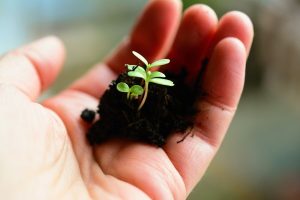By Bob Labozetta (UC Master Gardener, Mariposa)
Starting plants from seeds can save you money, give you the option of trying interesting varieties, and bring you closer to Mother Nature’s methods of propagation.
Different seeds have different germination rates, so refer to seed catalog or seed packet directions to determine when and how to start your seeds. Visit http://cemariposa.ucanr.edu/Master_Gardener/ for resources to determine the best times to start seeds based on the average last frost date in your garden.
Determine how many plants of each variety you want and plant two seeds for each plant you desire. Prepare labels for your containers, making note of specific varieties so you know what to purchase in following years from your best yields this year.
For spring planting, start seeds indoors in a sterile soil mix specifically made for seed starting. Garden soil is often too heavy and often contains dangerous soil pathogens.
You can use almost any container that has drainage holes in the bottom to start seeds. Sterilize any previously used container with 1 part bleach to 9 parts water, rinse well and allow to dry. Moisten your seed-starting mix to the consistency of a wrung-out sponge and fill your containers to within one-half inch from the top.
Follow seed packet directions to determine planting depth and any special needs they may require. Generally, seeds are planted at a depth of about twice their diameter. Keep seeds moist (not wet) until they germinate. Loosely cover the containers with a clear plastic bag until the seeds sprout. You can also use seed-starting trays with domed lids.
When seeds germinate, keep soil moisture consistent. Keep the temperature consistent as well, 65°F to 75°F for most seeds. To make your seeds germinate much faster and more consistently, use a seedling heat mat that gently warms the containers from the bottom.
When seedlings have emerged, move the containers off the heat mat and into bright light. Use fluorescent grow lights, LED grow lights, or put them in a protected area with good light. Keep grow lights or LED lights approximately six inches above the seedlings.
Water your seedlings regularly to keep them moist (but not too wet). Fertilize them with half-strength fertilizer every other time you water them. Seedlings put outside during the day should be brought back in at night. Start by putting them in a partly shaded area first. Gradually move them into direct sunlight for lengthening periods of time until ready for transplanting.
———————————————————————————-
UC Master Gardeners of Mariposa County serve Mariposa County, including Coulterville, Greeley Hill and Don Pedro. For gardening and event information, call 209-966-7078 or e-mail mgmariposa@ucdavis.edu.
Find us online at http://cemariposa.ucanr.edu/Master_Gardener, on Facebook (UC Master Gardeners of Mariposa County), and on YouTube at “UCCE Mariposa.” Listen to us on KRYZ 98.5 FM radio Wednesdays at 2 p.m. and Saturdays at 5 p.m.






